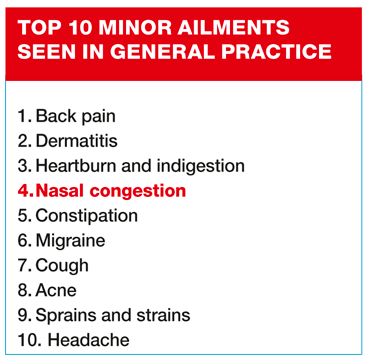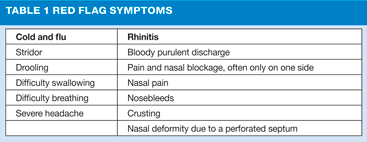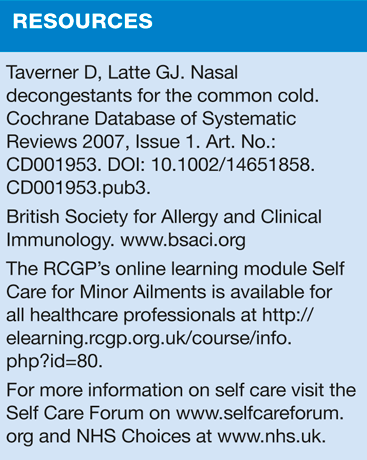Nasal congestion
Dr Knut Schroeder
Dr Knut Schroeder
FRCGP
GP, Concord Medical Centre, Bristol, and Honorary Senior Clinical Lecturer in Primary Health Care, University of Bristol
Self Care Forum Board member and author of 'Diagnosing Your Health Symptoms For Dummies' &
Sara Richards
RN
Specialist Primary Care Nurse, Practice Nurse Facilitator, Berkshire
Self Care Forum Board member
Nasal congestion is the fourth most common minor ailment presenting in primary care, with 5.3 million consultations per year. At a cost of £17.4 million per annum, it is a symptom that can be easily managed through self care
WHAT IS NASAL CONGESTION?
Nasal congestion occurs when blood vessels in the nasal mucosa are inflamed. This results in a blocked or congested nose and difficulty breathing. The primary underlying causes are rhinitis, such as allergic rhinitis e.g. hayfever, the common cold and flu (or flu-like illness), and nasal polyps.
Depending on the causative condition, sufferers may also experience accompanying symptoms:
- Rhinitis - while nasal congestion is the most common and bothersome feature of allergic rhinitis, rhinorrhoea (runny nose), itchy nose, sneezing, itchy and watering eyes also occur. Sleep can also be impaired
- Common cold/flu - nasal congestion is the most frequent symptom, with rhinorrhoea, sore throat, cough, fever, sneezing, muscle aches, headache, fatigue and post-nasal drip potentially present.
HOW COMMON IS IT?
Allergic rhinitis alone affects up to 25% of the population. Common colds affect adults on average two to four times per year, with children suffering up to six episodes.
WHAT CAN PATIENTS EXPECT?
Patients with a cold can expect symptoms to develop over one to two days and improve within a few days, although symptoms can persist for up to two weeks. Flu symptoms have a more rapid onset than cold symptoms. Recovery time is around a week, although fatigue can last longer.
Rhinitis sufferers can expect to suffer from nasal congestion for as long as their triggering allergen is present; this can be year-round for those allergic to dust mites or cat/dog dander, for example, and for several months during spring/summer in those with hayfever or allergies to moulds or spores. Rhinitis also increases the risk of an exacerbation of asthma.
WHAT CAN PEOPLE DO TO HELP THEMSELVES?
For those with colds and flu, the key advice is to stop the transmission of the virus by advising sufferers to:
- Catch it - catch coughs and sneezes into tissues
- Bin it - throw tissues away immediately
- Kill it - wash hands and clean surfaces regularly to keep them free from germs.
Also advise resting, eating well and keeping hydrated. For those with fever, extra fluid intake is recommended to avoid dehydration.
Rhinitis sufferers should be advised to take measures to avoid their triggers, e.g. for house dust mites clean soft furnishings and upholstery regularly, and for allergic rhinitis keep doors and windows closed during peak pollen periods (mid-morning and early evening).
WHICH OTC PREPARATIONS CAN PEOPLE USE?
Oral decongestants, such as pseudeoephedrine or phenylephrine, work by constricting the nasal blood vessels and can be used by adults and children over 6 years (depending on the product). Topical decongestants, in the form of drops or sprays, contain ephedrine, oxymetazoline or xylometazoline. While they can be used in adults and children from the age of 6 years (12 years for ephedrine), their use should be restricted to a maximum of seven days in adults (five days in 6-12 year olds), as prolonged use can cause rebound congestion.
Patients with nasal congestion due to rhinitis can also be recommended intranasal corticosteroids and/or antihistamines. Common intranasal corticosteroids include beclometasone, fluticasone and triamcinolone, and provide superior relief of nasal congestion symptoms in those aged 18 years and over. The full effects can take several days to develop, therefore antihistamines can be used in the interim for relief. These are also a good option for patients who prefer oral treatment or who are younger than 18. Older antihistamines, such as chlorphenamine (for use from 1 year onwards) or promethazine (from 2 years, depending on product), can cause drowsiness, unlike newer antihistamines, e.g. acrivastine (from 12 years), cetirizine (from 2 years, depending on product) and loratadine (from 2 years).
Oral decongestants and antihistamines are often combined with analgesics to relieve fever, aches and pains, and congestion. The MHRA advises that combination cough and cold medicines should not be used in children under 6 years of age.
WHEN SHOULD PATIENTS RETURN?
Patients should seek medical advice if their symptoms do not respond to treatment, worsen or if they develop red flag symptoms and signs. Unless rhinitis patients have red flag symptoms (see Table 1), they can be advised to continue with their self care choices.
WHAT ARE THE NEXT STEPS?
Cold and flu are self-limiting conditions and generally do not require further interventions, unless there are significant complications such as sinusitis and otitis media.
For rhinitis, hyposensitisation can be considered for severe symptoms of certain allergies, such as pollen.
Symptoms and signs that may suggest a more serious underlying problem are shown in Table 1.
SUMMARY
Nasal congestion is a troublesome problem in primary care. OTC treatments can provide effective relief and this should be supplemented in rhinitis sufferers with advice on avoiding triggers. The presence of red flags should prompt further medical assessment.
Related articles
View all Articles



